What a crazy and crowded year was 2019 for TOPPING. They were able to release not one, not two but three flagship DACs: the technical and serious DX7 Pro, its musical and playful brother D90 and the D70 that sits somewhere in the middle of those two. TOPPING didn’t forget their core fanbase and updated their 50 line and even added new affordable products, D50 was upgraded to D50s that made some nice quality of life changes for old-school loudspeaker enthusiasts, they added a much-needed A50 headphone amplifier and that must-have P50 external linear and regulated power supply that works with both of them.
D50s was already tested around here and we thought: Hey, why not try the rest of the combo? So A50 and P50 landed in our HQ and we will be ruthlessly testing both of them. A50 will be tested from small IEMs to portables and heavy-duty desktop headphones and P50 with be tested separately with A50, with D50s and together for a nice family reunion.
A50 is the most affordable headphone amplifier that we ever tested and the immediate question pops: will it sound good, will it be decent enough, or will it be mediocre at best? Let’s find out.
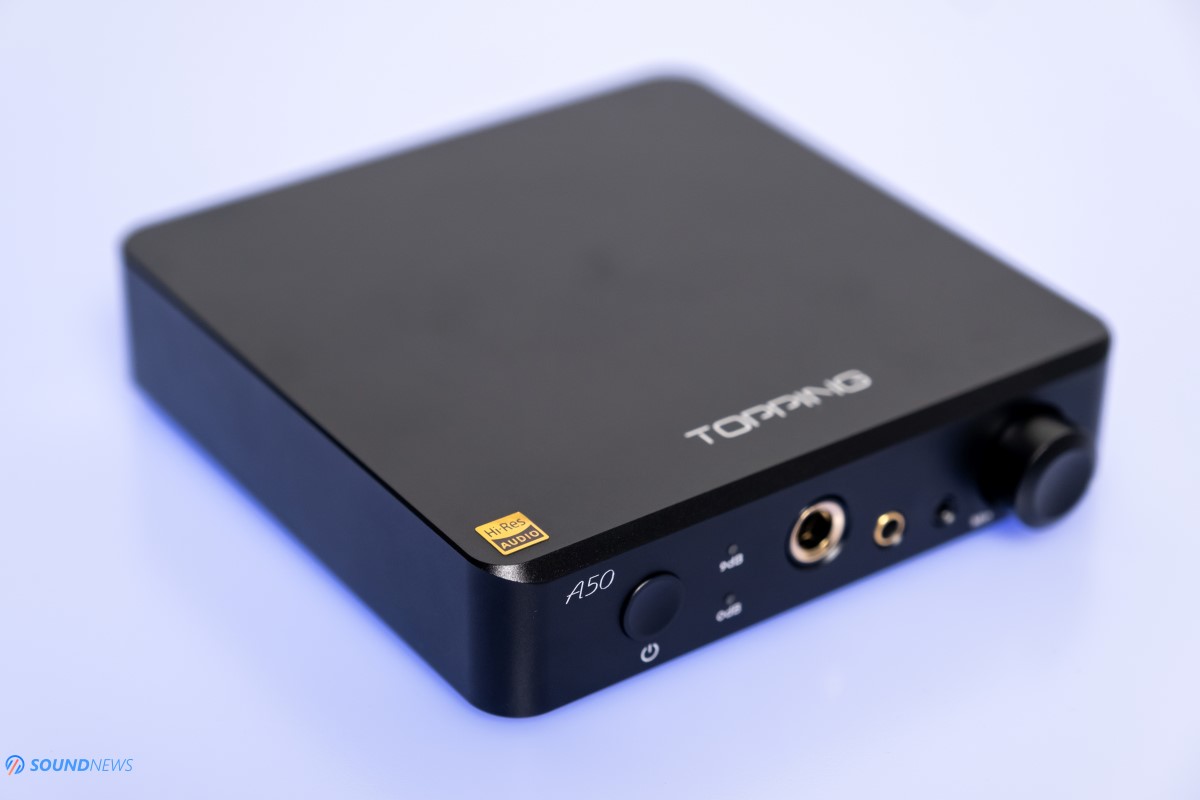
1. Unboxing & Package Contents
As with all TOPPING products, both came double boxed and carefully packaged. There is lots of foam inside for extra protection. It is so TOPPING seeing those total harmonic distortion plus noise and the frequency response measurements made with one of the best audio analyzers on the planet from Audio Precision. I’m very glad to see them in the user manual and I’m also glad they are not using some funny marketing tricks and are always straight to the point with just pure facts and real specs. There is a warranty card with both of them, A50 comes with a universal external switching power supply and P50 is coming with a power cable, with 2 short DC cables what will work with both A50 and D50/D50s, there is a longer DC cable for the A50 and that is basically it.
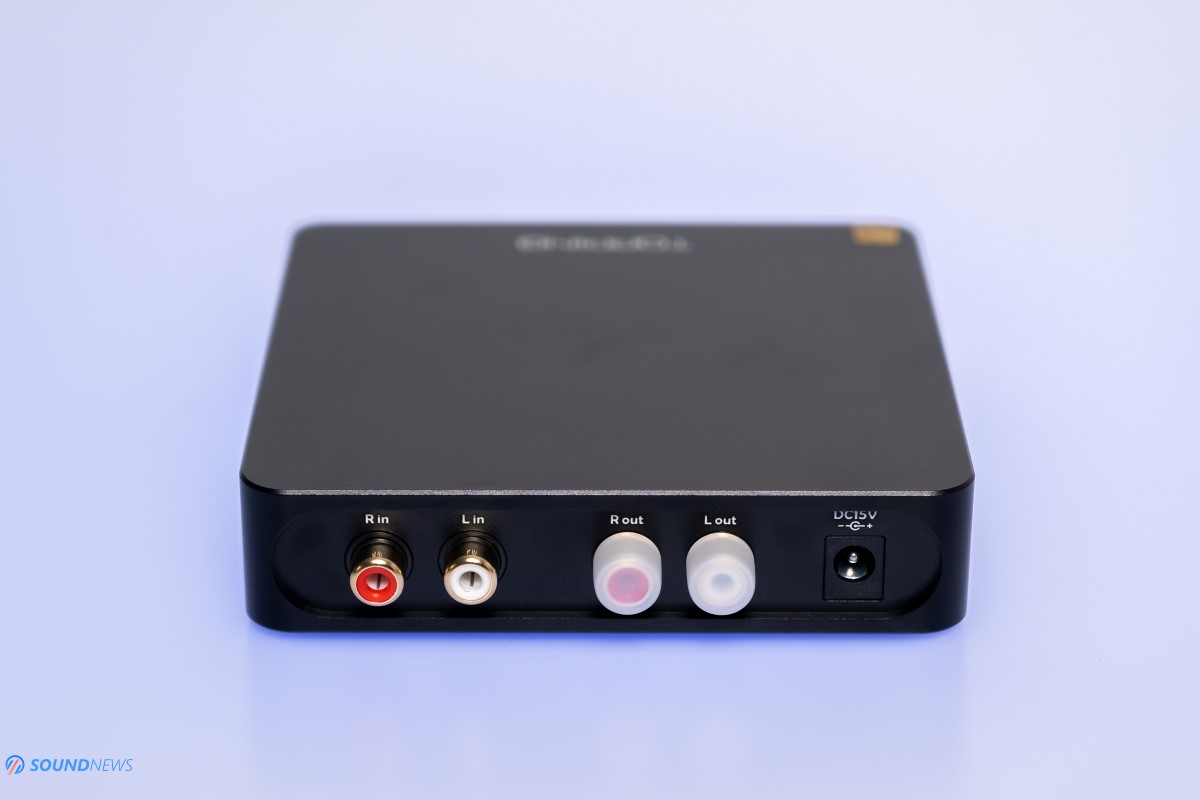
2. Design & Build Quality
I find them really beautiful and cute looking. Tolerance numbers are great, both are carved from single aluminum blocks. They are pretty heavy too, P50 weighs almost a kilo, picking it up it gives an impression of nice build quality. Both have a unibody design without any visible screws, you can spot them only underneath, so the fit and finish is excellent. I wish more manufacturers would put bigger importance to looks and finish, all three devices from the 50 line are really affordable but are looking like really expensive beauties.
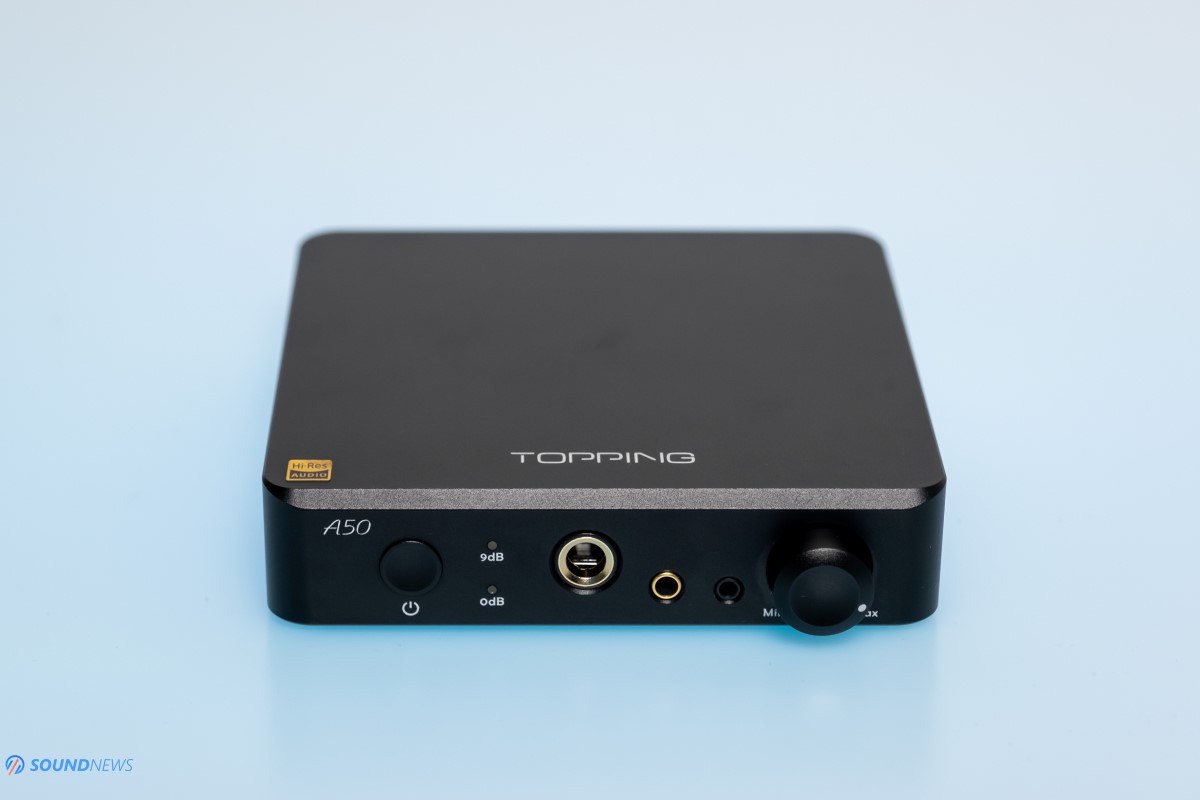
3. Controls & Connectivity
A50 has a clean front panel, from left to right there is your On/Off button, once it is powered a short press with change the gain setting from low (0 dB – unity gain) to +9 dB, there is a 6.35mm (1/4”) jack, a 3.5mm (1/8”) jack and a 2.5mm balanced output. I would like to see a 4.4mm jack instead of that 2.5mm because of a bigger surface area, of less internal resistance/impedance and also because 4.4mm feels much sturdier by comparison. On the far right is your digital volume wheel and that is it.
On the back, A50 has one RCA input, one RCA output in case you’ll want to use as a preamp and there is a 15V DC input, so a really simple and straightforward unit.
As for P50, it has a white LED indicator in the front, an AC input on the back, a single 15V 1A DC output and two 5V 1A outputs. P50 can power 3 devices simultaneously and you actually use it with any device that can be powered by 15V or 5V DC, not just with D50/D50s and A50.

4. Under the hood of A50 & P50
First of all, I’m glad that TOPPING implemented that unity gain of 0-dB that works wonders with IEMs and sensitive portable headphones. A big majority of desktop headphone amps do not have a unity gain and as a result, will not work that great with sensitive IEMs. There isn’t a better gain setting for ultra-sensitive IEMs, so it’s cool seeing it here.
TOPPING went with a digital volume implementation based on JRC1195 for a precise volume adjustment. Even at the lowest volume, both channels will be perfectly matched. Late night music listeners rejoice!
As for the amplification, TOPPING went with a reference tuning instead of a warmer or mellower tuning. Two incredibly linear sounding LME49720 op-amps will work as low-pass filters and the final power stage is based on resolute and clean sounding AD8397. There are a lot of companies using the AD8397 as the final output stage (Headamp Electronics, Shanling and FiiO are coming to mind) and thanks to its transparent and speedy approach to music reproduction, I am already imagining how A50 might sound.
If you like to tinker with your gear, TOPPING got you covered and put that LME49720 on DIP-8 sockets so you can change them with something better. Want the best? Look no further to the Burson V6 Vivid dual or to the Sparkos Labs SS3602.

For a good power reserve, slam and punch in the bass, TOPPING adopted high quality bi-polar and audio grade electrolytic capacitors from Nichicon Japan, more exactly the Muse BP series. I can’t open up the A50, so I can’t check the exact capacitance. There are also lots of solid aluminum electrolytic capacitors too so the power reserve should be enough even for desktop headphones for some high dynamic spikes.
In terms of power output, A50 can provide up to 1.1 Watts per channel into 32 Ohms on the both 6.35 and 3.5mm jacks and 2.2 Watts per channel in the same load on the 2.5mm balanced jack.
As for P50, I will just mention that it uses an oversized linear and regulated sealed toroidal transformer. It has very low magnetic leakage and it is designed to suppress EMC and EMI noises. TOPPING used again high-quality electrolytic capacitors with a big power reserve. More than 10.000 µF for the 15V output and more than 8000 µF for the 5V outputs giving enough power reserve for all three DC outputs that should squeeze some juicy dynamics from A50 and D50s.
Three ultra-low-noise linear voltage regulators from TI (TPS7A4700) designed for high-accuracy and high-precision will maximize system performance. This particular chip is ideal for powering op-amps, ADCs, DACs, headphone amps, and any other high-performance analog circuitry.
Ok everyone, time to hit some eardrums.
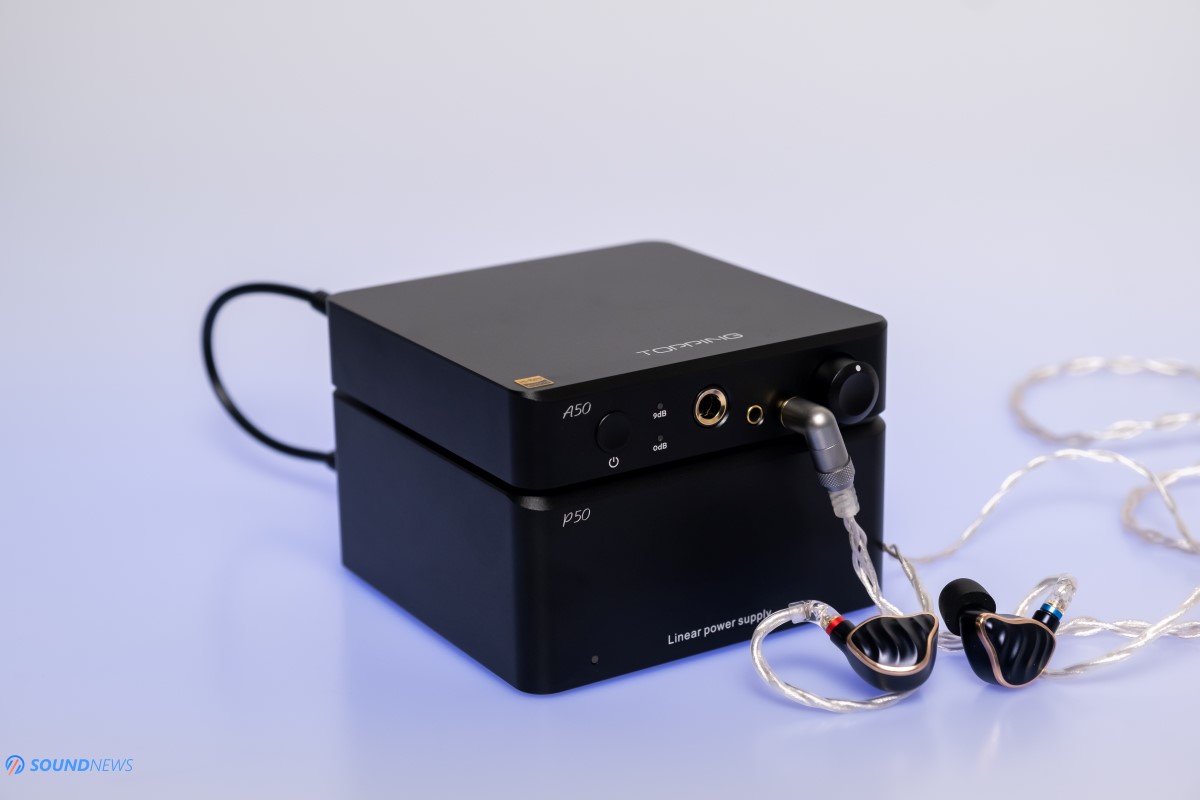
5. Sound Performance
5a. A50 with its stock switching power supply
First on the test bench was the FiiO FH7 IEMs that are quite sensitive when it comes to noise. I connected them to the 2.5mm balanced jack and selected the 0-dB gain and luckily, I can’t hear any traces of noise at any volume level. The background is completely black and there isn’t any hum or hiss. In this regard, A50 works considerably better than pricier units as SMSL SP200, Erzetich Bacillus and Headamp Gilmore Lite Mk2. If I am switching to high gain, a bit of noise comes forward and it is present at any volume level. Do note that high gain was put there only for low sensitivity desktop headphones and not for such easy loads. My other IEMs were also dead silent on the low gain and I could listen to them peacefully at any volume.
When it comes to power, I was at about 10 o’clock on the 3.5mm jack and at about 9 o’clock on the balanced out. There are two great things that I want to add: it goes a long way until I reach my comfortable listening level of 85-90 dB, so low-level listening works great on A50. Another great thing is that there is a lot of volume left on tap, so dynamics and headroom felt absolutely bottomless and it could drive any IEMs to ear-blasting levels.

When it comes to sound, A50 sounded linear and extended in the frequency response. A50 doesn’t want to impress with anything particular and in this regard, it sounds a lot like the D50s DAC from the same line of products. A50 is quite a detailed sounding amplifier, on the micro and macro scale, it has a fairly fast presentation in detriment of a slower and mellower approach. Combine it with a faster-sounding source like the D50s and this combo will always have a faster pace, and engaging type of sound but without adding a lot of coloration on any range.
With the stock switching power supply the sound is by a hairdryer sounding with less emotion in the midrange. There is also a slight glare in the treble region that makes it grainy and a bit bothersome in the long run. I did some burn-in for about 40 hours hoping that “digital glare” will go away but in all fairness, it remained. I’m reminding you that A50 in its stock form is just by a hair tilted towards a brighter sound, with more treble emphasis, with a lesser accent on the midrange and with a nice extension in the bass.
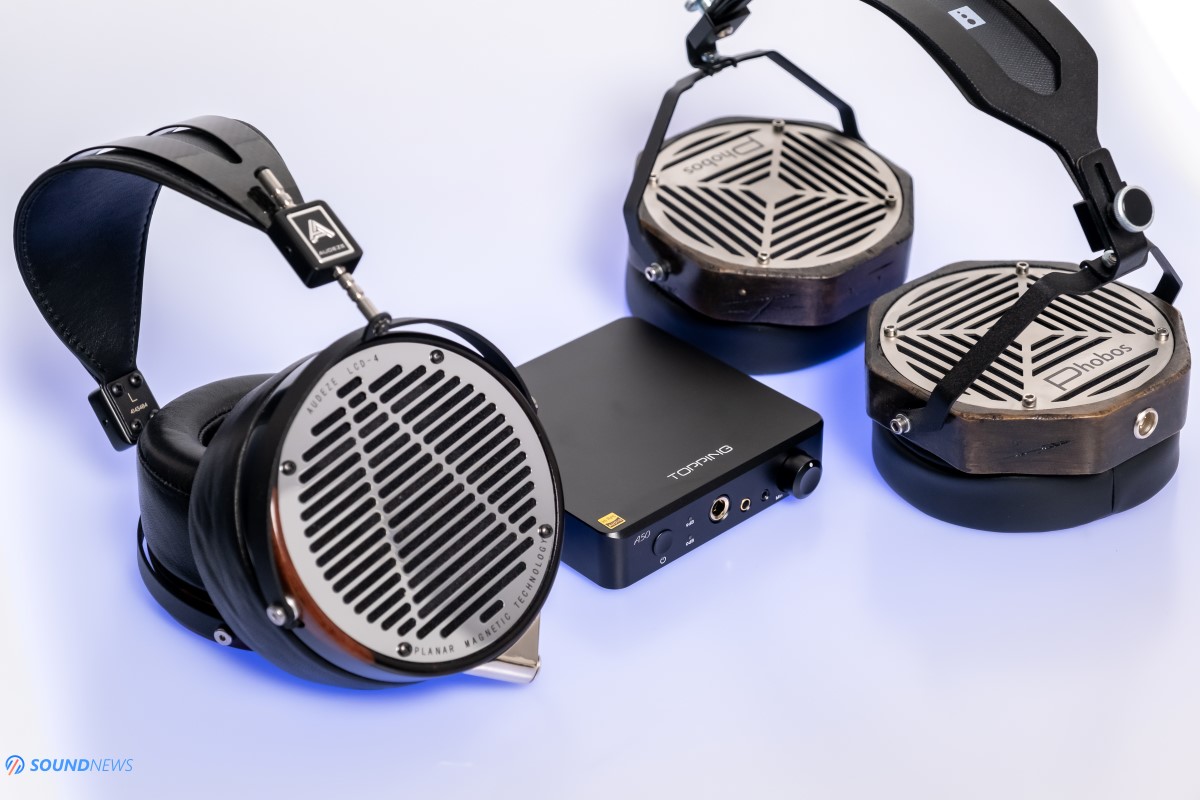
The soundstage is decent enough and it is sounding a lot more like a desktop unit, than like a portable unit. With some particular music, the stage is going past my shoulder level and I can dissect a big majority of my music and walk by all those notes quite easily. Depth is decent but less impressive than soundstage, I am blaming the power supply and its (much weaker) power filtering that makes the sound more like 2D sounding than 3D sounding.
Moving on to portable headphones like Sennheiser Momentum 2 and Meze 99 Classics, I’ve had a pleasant surprise with these two. Momentum 2 and 99 Classics were made to be smooth, relaxing and easy-going with a lesser emphasis on slam, on speed or on details. They were made to be used for longer periods of time so it was natural going for a relaxing type of sound. Since A50 is a snappier sounding amplifier that wants to impress a lot with its detail retrieval and transient response, it actually worked as a cure for that lazy duo of headphones. A50 infused a bit more energy in them, made them more impressive in terms of bass slam, impact improved quite a lot, their wide stage (for a closed headphone) remained the same and their depth too. I was able to listen to some faster electronica and rock, so I could definitely say that A50 counterbalanced the issues of those two headphones and made them better sounding.
Power-wise, with a serious power reserve, A50 was easily driving them even at half volume and at higher volumes, I was feeling how dynamic membrane was almost breaking due to excessive magnetic force applied to them. Obviously, both were driven at their best and they sounded as I know them on my bigger and much more expensive headphone amplifier.
Moving on to low sensitivity headphones, I will first state that all of them are wired with 4-pin XLR jacks or with 6.35mm jacks so I was unable to test the balanced 2.5mm output, so I will be experiencing only half of its power compared to my IEMs or portable headphones.
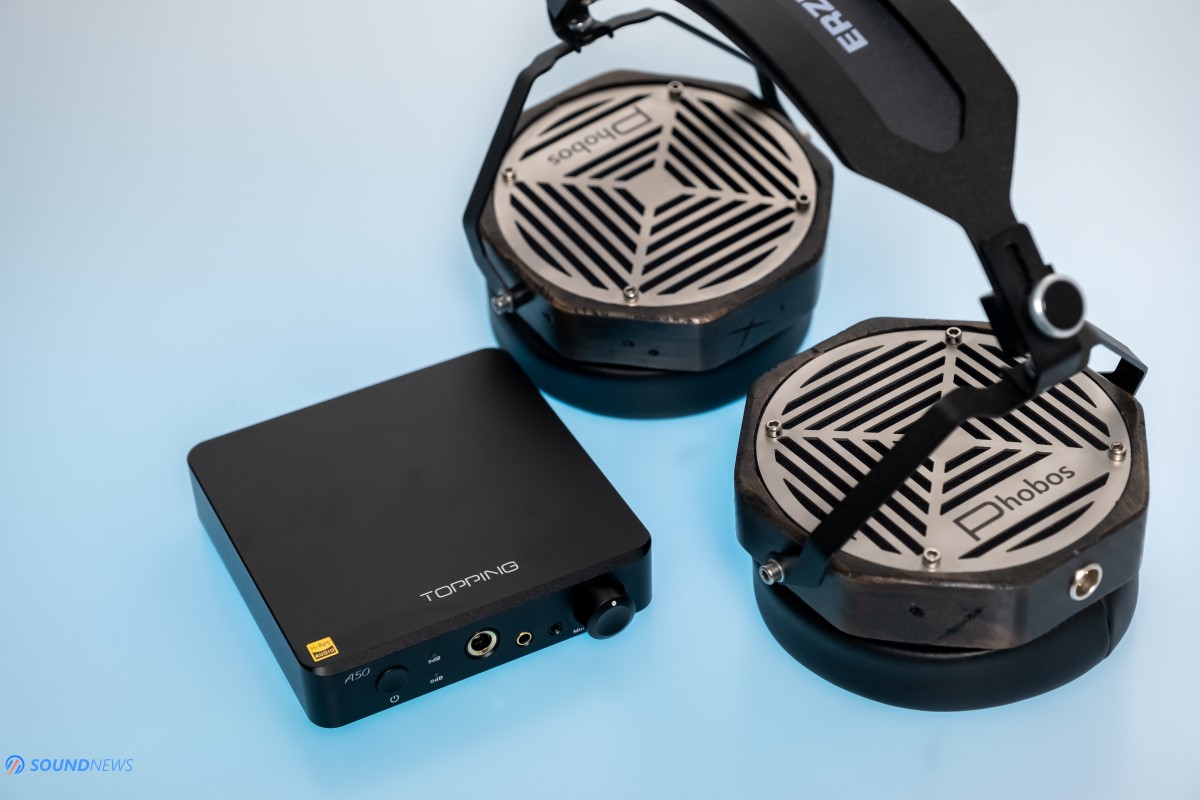
The biggest surprise, by far was the XL-sized Erzetich Phobos. As you already know, all headphone amplifiers can sound slow and mellow with such type of music, but not all of them can sound fast, snappy and really impactful. That is why I started listening directly to some crowded and engaging tunes. When I engaged I.P.R. – Cartography (2015) I couldn’t believe my ears that I am listening to such a small headphone amp. I was hearing a bold, big, impressively engaging and really toe-tapping experience with Phobos. This particular headphone has one on the biggest planar drivers that I know, it even dwarfs a pair of Audeze LCD-4 or Hifiman Arya near it. Blaz Erzetic – creator of this headphone is a rock/metal listener himself and he tunes his headphones to sound great with raw energetic music. Phobos sounded as I know them connected to big desktop headphone amps. Detail retrieval and transparency were not on the same level but everything else clicked into place. I was head-banging with a big smile on my face and with this particular headphone, it worked wonders. Power-wise, I never passed the 12 o’clock position on the 6.35mm SE jack so naturally, a lot of headroom and volume were left on tap and it was driven to its full potential.
Quad ERA-1 was another great example of a great system matching. They have a fast, but also a relaxed tuning with just a small roll-off in the treble and an emphasis in the midrange. A50 counterbalanced those immediately and made them more linear and truer to life sounding and again I couldn’t go past that 12 o’clock position. Roll-off in the treble was cured and I was hearing more information up top, midrange became clearer sounding but less musical in the process. Overall, an amazing experience with both headphones and all fairness A50 does not perform like a $169 unit but more like a much bigger and expensive unit.
The only two headphones that weren’t driven to their fullest potential were the Audeze LCD-4 and the Hifiman Arya. I was almost maxed out on both; dynamics were a bit shy and reserved sounding. I didn’t experience the same slam and impactful presentation; I was just less impressed with them because of that limited headroom. The sound became smaller in size, depth almost disappeared and it just wasn’t a satisfactory experience.
Truth to the told, there are only few desktop headphone amps that can drive them properly at their fullest, even my former 16 Kilo (35 pounds) Audio-GD Master 9 balanced headphone amp wasn’t driving Audeze LCD-4 to their fullest so it doesn’t come as a surprise that TOPPING A50 can’t do that either.

5b. A50 connected to P50 Linear Power Supply (PS – from now on)
I returned back to the super-sensitive FiiO FH7 IEMs and on high gain (+9 dB) on both 3.5mm and 2.5mm jacks, the background noise remained the same, that low-intensity hiss was there on every volume position. Engaging low gain, I wasn’t hearing a nasty gremlin shushing into my ears, so there wasn’t any trace of that, just a dead silent background.
When it comes to sound, that slight grain I experienced before and that digital glare was completely gone. Midrange finally started sounding a bit fuller, a bit meatier, there was more meat to the bone. Male voices started sounding like actual males and not like female soprano voices. A bit of charisma returned; that naturalness that was lost returned back too for a more enjoyable experience. Upper treble remained as detailed, but less piercing and less painful in the long run. I even find it cleaner and even more extended but calmer and more natural sounding. The difference is not a night and day one, but with detailed sounding IEMs like FH7, I can easily detect those very welcomed changes. There was a change in the slam and in the transient response too, A50 started sounding even snappier, carrying more air volume and pushing a bigger sound pressure level with every kick.
When I moved to my portable over-ear headphones, the biggest improvement was felt in terms of transparency and depth. From a 2D left to the right plane, without too much information on top of my head or bellow it, the sound because a tad deeper and wider, not completely 3D but should I say 2.5D.
I could hear deeper, notes started coming from multiple spots and different angles and A50 started sounding like a proper desktop headphone amplifier with this small and fairly affordable trick.
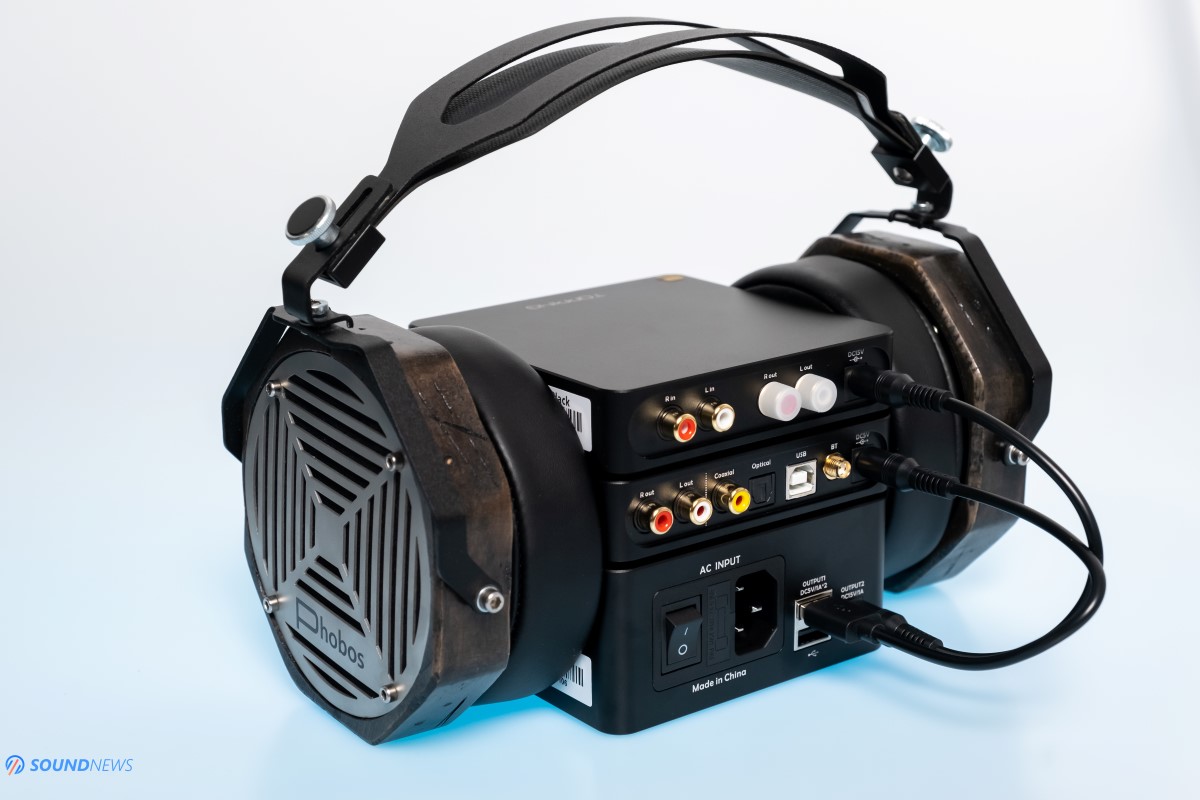
In terms of frequency response, from linear sounding Momentum2 and 99 Classics on that stock switching PS, they were back to sounding as fast but full-bodied, heavier in tone and overall, I felt them coming back to their senses with their true nature.
Moving on to the most revealing headphones of this test, Erzetich Phobos was able to show the full unlocked potential of A50 while it is connected to P50. I had the same feeling as I had with my IEMs and portable headphones so I would not repeat myself, but this time I also heard an improvement in terms of driver control, like they had a firmer grip especially on faster music. Sub-bass for example not only was going quite low, but it started hitting in an instant and stopping at the right moment without lingering for micro-second longer. As for impact and slam, with P50 I experienced like a bigger portion of my ear and body is being hit, like more air is moving towards me, a weird experience at first but a pleasant one in the end.
That slight haziness that was present on the stock power PS disappeared as well. I could focus on a macro-scale with the stock PS, but not that much on the micro-scale. With P50, I’m focusing on some tiny details much easier and can look deeper into the recording.
I will summarize that A50 being fed my P50 resulted in: a better driver control, a better transient response, a better slam, a clear improvement in terms of depth, a bigger soundstage, a slight improvement in the midrange area making it fuller and more life-like sounding and a decrease of treble ringing, making it more manageable and easier to listen. Were those $119 cleverly spent on the P50 and it is worth upgrading to it? There is not a doubt in my mind, P50 is a must-buy accessory for the A50 headphone amplifier.

5c. P50 Linear Power Supply connected to the D50s DAC and to the A50 headphone amplifier
In my TOPPING D50s review, I complained about it having a grey background while being fed by a USB port of my desktop PC. It was so obvious that even at low-level listening I could spot that hiss with headphones and speakers alike. While being fed by a smartphone charger, the noise drastically lowered, but now at the higher volume, I could hear that dirty background. It was very annoying hearing it, since it distracts me from focusing on anything else. Only when I connected it to an external power bank the noise went down and I could finally listen even at 85-90 dB of SPL without being distracted by anything.
When I connected D50s to P50, I felt an overwhelming feeling of silence and of big emptiness between each musical note. The sound became even deeper compared to the external power bank and transparency increased as well. The more I listened to this, the more it kept reminding me about a DAC/Amp that I have tested in the past – it was the TOPPING DX7 Pro, I could almost swear that I am listening to the same combo.
In its stock form, D50s was linear and technical sounding with a decrease in emotions. It was detailed but a bit sterile and uninvolving sounding. While being fed by P50, on top of being as clean and transparent, it started sound livelier, it infused more soul into my music, it became less stiff sounding and more relaxed too. I can safely say that at this point I can’t attribute any more words as sterile, stiff and bright to D50s.
P50 had the same positive effects on D50s as it had on A50's performance, but to a much bigger degree thanks to that huge decrease in the noise floor. It really depends on how you are powering that D50s or D50 and how clean and detailed is rest of the acoustic chain, but with a P50 you no longer need to worry about any noise or about a decrease in dynamics.
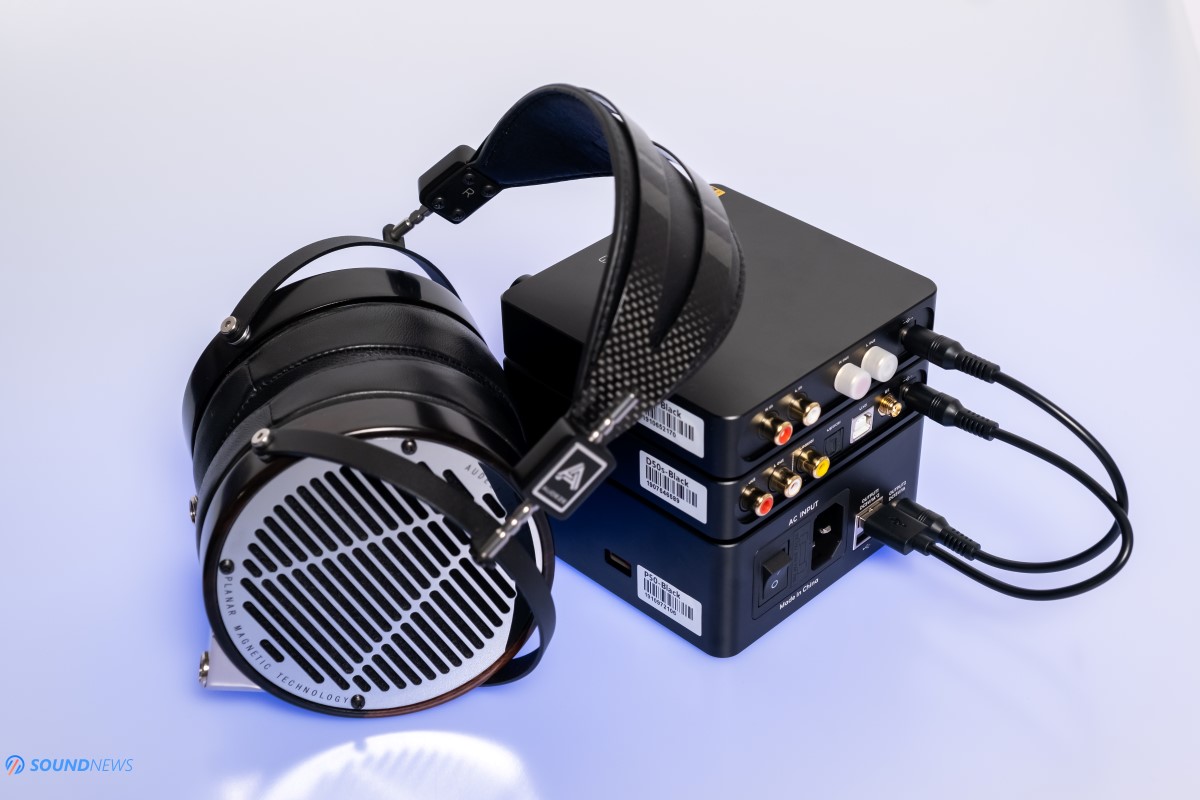
6. Conclusion
TOPPING A50 is indeed the most affordable headphone amplifier that I have tested around here, but boy, it delivered on all fronts. It has a really nice build quality, looks like a premium unit. It works like a charm with D50 or D50s and once you connect it to P50 linear power supply, all its issues in the stock form are completely cured. From dry midrange and bright upper region, it transforms into a natural, detailed and transparent sounding amplifier without a trace of that nasty digital glare.
As for the P50 linear power supply, it extracted the best D50s DAC and A50 headphone amplifier could possibly offer, that huge decrease in background noise was godsent for D50s and it immediately put it on the same level with TOPPING DX7 Pro in terms of technicalities.
A50 is a great starting point for headphone enthusiasts or as a secondary transportable headphone amp and at just $169.99 I see little to no competition at all.
PROS:
- Cute, small and sleek looking devices with a solid build quality
- Easy integration into tiny spaces, highest WAF known to me
- Sounds linear and super-extended on both ends (sub-bass and top octave), lacks any sound coloration
- Resolution and transparency are more than decent
- Lots of power for such a small unit
- Extended and wide soundstage
- Excellent pace, rhythm, and timing with fast kicking dynamics
- Very good driver control
- An unbeatable value
CONS:
- With the stock switching power supply - midrange is a tad drier and treble a tad hotter

 Free Shipping
Free Shipping
 Price Match Guarantee
Price Match Guarantee
 Apos One-Year Transferable Warranty
Apos One-Year Transferable Warranty
 45-Day Return
45-Day Return

![Apos Audio Apos Cable Apos Flow Headphone Cable for [HIFIMAN] 3.5mm | Sundara / Ananda / Arya / Susvara / Susvara / HE1000SE / HE400i / HE400s / HE1000 V2](http://apos.audio/cdn/shop/products/apos-audio-apos-cable-apos-flow-headphone-cable-for-hifiman-3-5mm-sundara-ananda-arya-susvara-susvara-he1000se-he400i-he400s-he1000-v2-29869837451435_{width}x.jpg?v=1630546104)






